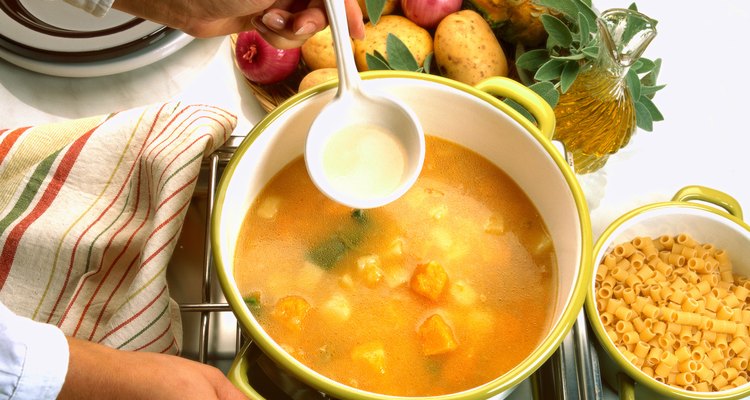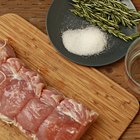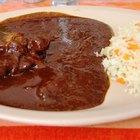
Diluting sauces, soups and gravies isn’t just about stretching a dish so that more food can go a longer way, it’s a technique that gives you, the cook, complete control over body, texture and consistency. Certain cuts of meat are improved when the juices are diluted and combined with other liquids; using creative ingredients to dilute a dish adds layers of taste without cutting flavor.
Braising Techniques
Braising is a slow-cooking technique that uses juices drawn out of meat by simmering in water. Diluting these meat juices with water, stock or wine adds a depth of flavor to the meat stock and further bulks-up your sauce or gravy. Another benefit of braising in liquid and diluting the juices is that this technique takes advantage of the flavors locked in tougher – and much less expensive – cuts of meat.
Thinning Sauces
The best sauces begin after a meat such as chicken breast, beef or pork has been browned. The meat drippings provide a base of velvety flavor you can dilute with water and thicken to make a gravy or sauce. When oven-baking meats, use dilution to create even more liquid so your dish doesn’t dry-up during a slow-cook. Thin your sauce with enough water or broth to provide a flavorful bath for the meat. During baking, your diluted sauce slowly reduces, becoming more concentrated while providing constant moisture for the meat.
Creative Liquids
There are several low-fat options beyond water and stock that add depth of flavor and nutrition to diluted sauces. In his book, “The Flavor Point Diet,” Dr. David L. Katz recommends diluting sauces with beer, cider and carrot juice. Add these liquids to your skillet after browning the meat, bring to a boil and simmer for 2 to 3 minutes. Taste and adjust the seasonings before pouring over the meat.
Seasoning Tricks
Dilution can also be used to save a meal that has gone awry. When a dish is too salty, spicy or bitter, diluting with water can save the day. To prevent a runny dish, add a thickener such as cornstarch or flour, blending into a slurry with a little water first before adding to your dish. Sugar and citrus-based liquids such as tomato and lemon juice are good diluters to help neutralize spice and cut through the salt. Brewing tea such as green tea or herbal spice teas infused with cinnamon is another trick that allows for dilution without sacrificing flavor.
Pickling Exception
When working with vinegar for home-preserving foods such as pickles and beets, dilution is not recommended. The University of Minnesota Food Extension Services suggests adding a little more sugar if the pickles seem too tart, because diluting the ratio of vinegar with water results in pickles with a soft texture and poor flavor.
Related Articles

The Effect of Salt on the Tenderness of ...

Uses of Saltpeter in Food

How to Make Marinade for Roast Beef

How to Cook Corned Beef Without Being ...

How to Neutralize Food Seasoned With ...
Adding Vinegar to a Brine for Pork

Does Simmering Ground Beef Make It More ...

How to Brine Pork Roast

How to Marinate Steak

How to Make Mole Sauce

Can I Use Baking Powder to Thicken ...

How to Cook Muskrat

How to Make Teriyaki Sauce
Can You Soak Pork Chops in Milk?

Foods That Are Good for Arthritis Pain ...

Liquid Smoke Ingredients

Uses for White Wine Vinegar

How to Use Coke to Tenderize Pork

How to Steam a Brisket of Beef

How to Soak Deer Meat in Baking Soda
References
- Fine Dining Lovers: Cooking Techniques
- The Flavor Point Diet; David L. Katz
- The Kitchn: Soup Too Salty?
Writer Bio
For more than 10 years, Carol Butler has run a small, off-grid furniture business with her husband and is a regular contributor to the Edible community of magazines. As staff writer for RichLife Advisors, she covers financial planning and other industry-related topics. She holds a B.F.A. in theater arts.
Photo Credits
Stockbyte/Stockbyte/Getty Images